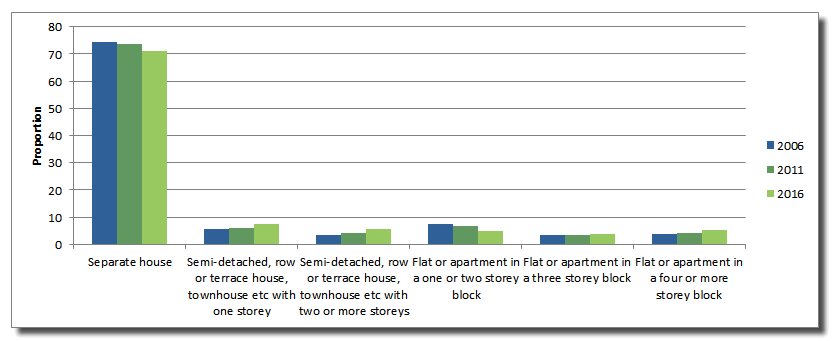Structure of Dwelling (STRD)
This variable classifies the structure of private dwellings. This variable is applicable to all private dwellings enumerated in the 2016 Census.
How this variable is created
Up to and including the 2011 Census, information on dwelling structure was collected by Census Field Officers in the Collector Record Book at the time the Census forms were delivered. For the 2016 Census, data on this topic for mail-out areas (see How we collected your information) was collected during field work by ABS Address Canvassing Officers in the lead-up to the Census, as part of establishing the Address Register as a mail-out frame for designated areas. In areas enumerated using the traditional (non mail-out) approach, the topic was collected for each dwelling by ABS Field Officers when delivering forms. Structure of Dwelling data for non-responding dwellings in mail-out areas was updated as required by ABS Field Officers during the 2016 Census enumeration period.
Certain types of dwelling structure, such as 'Improvised homes, tent, sleepers out' were given particular attention during processing. This resulted in identification and amendment of a small number of dwellings that had been mis-classified.
Variable history
Some information on the structure of private dwellings has been collected for all censuses since 1911, though the specific types of classification used have varied significantly between censuses. Since 1976 this variable has been collected by Census Field Officers instead of being identified by respondents on the Census Household Form.
For the 2016 Census, there was a change to one of the response categories for this variable. The previous category of 'Caravan, cabin or houseboat' has been separated into two categories: 'Caravan' and 'Cabin, houseboat'.
Non-response rate
The non-response rate for Structure of Dwelling was 0.5% (0.1% 2011).
Non-response for this variable was largely caused by previously unidentified dwellings being added to the census frame when a member of the public contacted the Census Inquiry Service, and through late GNAF (Geospatial National Address File) updates to the Address Register which did not include dwelling structure information. The Census Inquiry Service did not record dwelling structure and therefore it was left as a not stated response. Similarly if a dwelling was added through the GNAF update, and was not visited by a Census Field Officer, then dwelling structure was not recorded. Prior to processing, a separate desktop canvassing exercise was undertaken to assign a dwelling structure code to the late GNAF updates and CIS created dwellings, resulting in a number of amends being applied.
All dwellings with no dwelling structure coded went through an imputation process during processing to try and assign a structure code based on surrounding dwellings. Where a structure was unable to be assigned dwelling structure remained not stated. This is similar to the imputation process applied for the 2011 Census.
Data usage notes
Due to the change in the way dwelling structure data was collected in 2016 for mail-out areas (the majority of dwellings in Australia), caution should be applied when comparing to previous Census collection cycles.
Minor inconsistences in dwelling structure counts may also exist between Censuses due to subjective interpretation of structural definitions between individual Field Officers.
While there were no classification or definition changes to dwelling structure, the change in procedures for collecting this information has resulted in differences between 2011 and 2016 data for mail out areas. This is particularly noticeable in the separate house, semi-detached, row or terrace house, townhouse etc categories, as well as flat or apartment in a one or two storey block.
Flats attached to houses are at a high risk of being missed in canvassing as they are hard to identify – this is also the case for flats above shops.
Dwelling structure was predominantly set by address canvassers in mail out areas, but Census field officers were also able to update the dwelling structure during the enumeration period for non-responding dwellings. This may have resulted in different structure codes being set within the same complexes.
Other items collected by the Address Canvassing process include: Dwelling location, Type of Non-Private Dwelling, and Dwelling type. These variables had further verification by Field Officers, so the impact on time series is minimal.
Dwelling structure proportions for selected categories - 2006 - 2016

Further information
More information on Structure of Dwelling is available in the 2016 Census Dictionary.
 Print Page
Print Page
 Print All
Print All